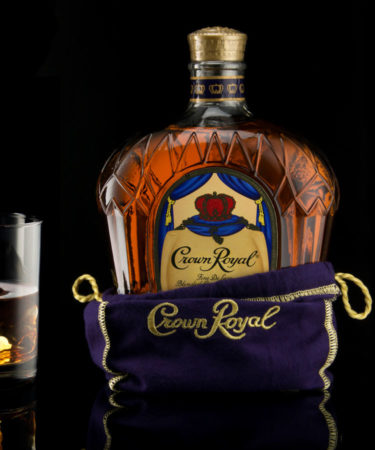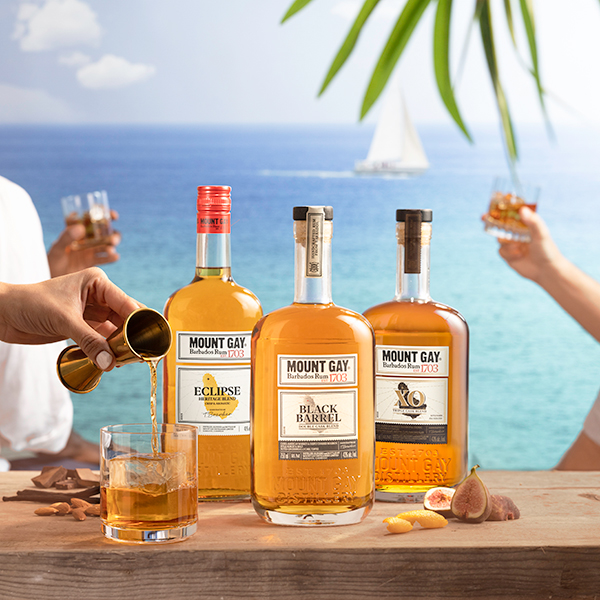There are plenty of incredibly tasty Canadian whiskies worth your time and talents. But as with any drink, learning or consuming, it’s best to start with one. Why not start with the Canadian whisky that’s famously “Fit for a King” and comes, as far too few things do, sheathed in velvet?
Here are 10 things you should know about Crown Royal and its small kingdom of Canadian whiskies.
A Jewish Canadian Whisky for English Kings.
So a rabbinical student meets the president of Seagram’s at a Sephardic shul in Montreal. No, not the set up for a joke. It’s the key to the soul of Crown Royal Deluxe — the first, and to this day, flagship whisky of the Crown Royal brand. In 1943, Seagram’s then-president Samuel Bronfman told visiting rabbinical student Solomon Maimon how his first two attempts at distilling Crown Royal were miserable failures. The recipe was only salvaged — or, rather, saved — when Bronfman’s own rabbi told him to imbue the whisky with a spiritual purpose, yielding a smooth blend of no fewer than 50 whiskies and giving birth to a now-international drinks empire. (Incidentally, the Crown Royal symbol and iconic purple bag look a lot like the Jewish keter malchut crown and tallit, or prayer shawl bag, respectively.)
Did You See ‘Darkest Hour’? Then You Saw Crown Royal’s Namesake.
The Crown Royal recipe might have gotten heavenly approval, but the origin of the whisky is very much worldly. In 1939, King George VI — he of “The King’s Speech” and “Darkest Hour” fame —became the first reigning monarch to visit Canada. Crown Royal Deluxe was created in his honor. The King and his wife, Queen Elizabeth, left with 10 cases of the stuff on their train, in easily the classiest liquor run in history.
We Also Owe Crown Royal to Non-Patriots.
American non-patriots, that is. During the American Revolution, an estimated 15 to 25 percent of the population remained loyal to the crown. Their solution? Head up north, where they could continue to genuflect to a guy in a fancy cape. Thankfully, at least some loyalists became what were known as “gristmill” (grain-grinding) operators, eventually repaying their abandonment of ‘Murica with delicious Canadian whisky.
Crown Royal: The World’s Best?
If you’re bored and want to get punched, disagree with someone, preferably a drunken someone, about the world’s best whisk(e)y. Of course, if you’re “Whiskey Bible” author Jim Murray, this is a professional hazard. He braved it stoically when he named a Canadian whiskey — Crown Royal’s Northern Harvest Rye — the best whiskey in the world in 2016, with nary a Scotch in sight in the top five. The nomination was even more astounding considering Northern Harvest tied with the previous year’s winner, Yamazaki Single Malt Sherry Cask 2013, with an all-time high score of 97.5. Oh, and Northern Harvest cost $50 or so, in comparison to Yamazaki’s then $160.
Crown Royal Is Not Rye Whiskey. But It Can Be. If It Wants To.
When it comes to whisky, Canada’s like the Wild West, except up North and probably with a lot less spitting and cursing. Either way, rules for Canadian whisky production are comparatively lax. Add to that the country’s less-than-tropical temperatures, and you get why rye is a staple ingredient in its whisky. That doesn’t mean Canadian whisky = rye. Far from it. Unlike American “rye whiskey,” which legally must contain at least 51 percent rye, Canadian whisky can have zero, some, or a whole lot of rye in its mash bill. Other common ingredients are corn and barley. It’s a bit of a distillation free-for-all.
Sherry. Wine. Oak. Ash. It’s All Crown Royal.
One of the only unifying rules of Canadian whisky is aging: All whiskies have to be aged a minimum of three years, though a lot get a lot more time in the barrel. What kind of barrel, you ask? Well, there’s some wiggle room. Remember how strict we are in the U.S. about bourbon aging? (Bourbon whiskey can only be aged in charred new oak barrels that have been blessed by a dude with an old-timey beard. O.K., so that last part might not be entirely true.) Being Canadian, Crown Royal is under no such scrutiny. That’s how you get one company putting various proportions of corn, barley, and rye whisky into anything from virgin, charred new oak, and/or re-used charred new oak barrels, to Cognac and Cabernet Sauvignon casks. The flavors can span everything from spice and dried fruit to subtle smoke, vanilla, or caramel. Some experiments aren’t so welcome, as bearded whiskey sage Chuck Cowdery noted in his half-joking invective against the release of Crown Royal’s “Bourbon Mash” whisky, a bottle that may lead to some punching and/or beard-pulling down the line.
It’s Column-Distilled.
Many whiskies tout the fact that they’re pot-distilled, reason being the squat, rounded pot stills allow for greater extraction of congeners (think: flavor globules). Column stills are more often used (as is the case with vodkas like Absolut) for their efficiency — no clean-up between distillations, huzzah! — and ability to strip congeners from the distillate. Crown Royal stops well short of stripping away flavor, using its 12 column stills to efficiently crank out corn, barley, and rye distillates they can then blend — “like baking a cake” — with aforementioned legally unconstrained abandon.
It’s Ultra Canadian.
Crown Royal Deluxe isn’t just the brand’s flagship whisky. It’s quintessentially Canadian. Like, feeding a hockey player maple syrup-drizzled Canadian bacon on Canada Day. That’s because Crown Royal Deluxe combines the lighter body of column-distilled whiskey with the fruity, spicy notes you get from a good proportion of rye in the mash bill. That’s part of the pleasant unpredictability of Canadian whiskies: fewer rules, more options, surprising juxtapositions of flavor, texture, and, yes, purple velvet.
Tolkien Would Probably Drink Crown Royal.
If you know your Canada — which, as a proud geography-challenged American, you don’t — you’ll know that Crown Royal is produced in Manitoba, a central province squat on top of North Dakota and Minnesota. Crown Royal hails from a small town within Manitoba called Gimli, which is not only the name of an axe-wielding, elf-insulting, fearlessly questing dwarf, but is also Norse for “Home of the Gods.” True to the name, Gimli is home to epic statues like this. Next time someone says the purple bag is lame, go all Viking on them.
Hillary Clinton’s a Fan.
We love her power suits and she loves her whisky. At least according to one fuzzy video, in which the former senator knocks back a dram of Canadian spirit. See :30 for her official endorsement of Crown Royal. Clinton doesn’t finish the whole Canuck shot, mind you, likely in deference to America, freedom, and the almost certain need to be clear-headed (ahem, like all American heads of state).

